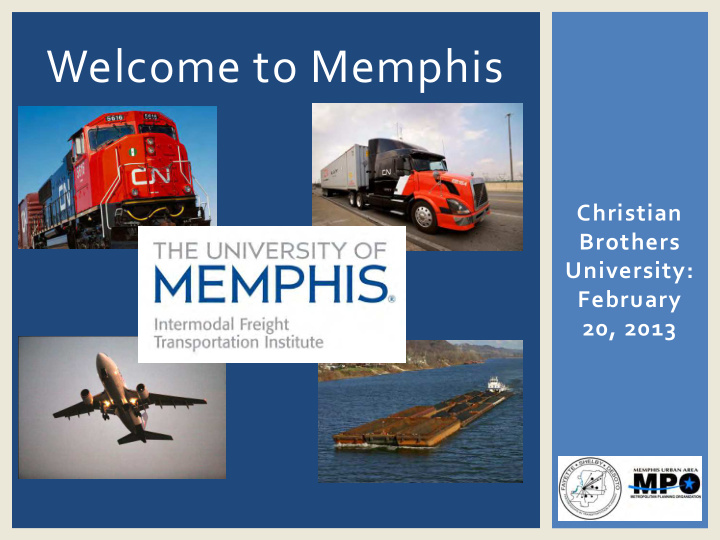



Welcome to Memphis Christian Brothers University: February 20, 2013
Our Friend from Cincinnati, OH You could have traveled from the Port of Greater Cincinnati. You would have traveled 740 miles and gone through 9 locks and dams before you reached the International Port of Memphis. 2
Our Friend from Washington, DC You could have traveled by rail on a CSX train to Memphis. It would have taken you to Huntington, WV Cincinnati, OH Louisville, KY and Nashville, TN before you reached Pigeon Park in downtown Memphis. 3
Our Friend from Atlanta, GA You could have traveled from the Peach State to the Volunteer State by road. You could have driven US-78 through Birmingham or taken I-75 to Nashville and I-40 down to Memphis. 4
Our Friends from Chicago, IL You could have flown out of either airport to Memphis. There are more than 115 flight combinations to get to Memphis International Airport from Chicago. 5
Memphis Freight Overview Memphis has the highest % of its work force in transportation in the nation. 6
National Freight Truck Traffic over the Mississippi Bridges 7
National Rail Traffic over the Mississippi Bridges 8
Current Train Volumes Compared to Current Train Capacity 9
Future Rail Corridor Volumes Compared to Current Corridor Capacity - 2035 10
Road, Rail & River 11
Inbound and Outbound Freight Tonnage by Mode 12
Quadra- Modal Strategy R AIL R UNWAY R IVER R OADWAY 13
Rail Yards Lif ift Capaci acity ty > 1.5 mil illi lion on TEUS 14
Road Congestion 15
River Port Commodities 7% 18% 6% Coal Food and Farm Products Crude Material 19% Petroleum 37% Manufactured Goods Other 13% 16
Warehouse Facilities in the Memphis Area 17
Memphis Freight Challenges
Roadways • Capacity on Freight-Intensive Corridors, i.e. Lamar Avenue/US 78 • Accommodating Through Truck Flows on I-40, I-55, and future I-69 • Intermodal Connectivity, i.e., access to rail, air, and water
Rail Connectivity between rail carriers Mississippi River Rail Capacity Containerized trade is a fast growing segment of foreign trade
River Maintaining water access to ports, i.e., dredging Landside and rail access to ports Container-on-Barge shipments
Runway (Air) Implementation of Aerotropolis Plan Roadway access to the airport
Overall Doubling of freight transportation by 2035 Increased buying from and selling to global markets Intermodal Connectivity and Coordination Understand forecasted growth for individual modes Assess capacity bottlenecks Congestion Reliability and Costs concerns
Tasks to Address Challenges Coordination of local and state governments Incorporating Freight Planning into Long- Range regional planning efforts Coordinating private sector needs with public sector planning Evaluating the current freight transportation network and measuring performance
Recommend
More recommend